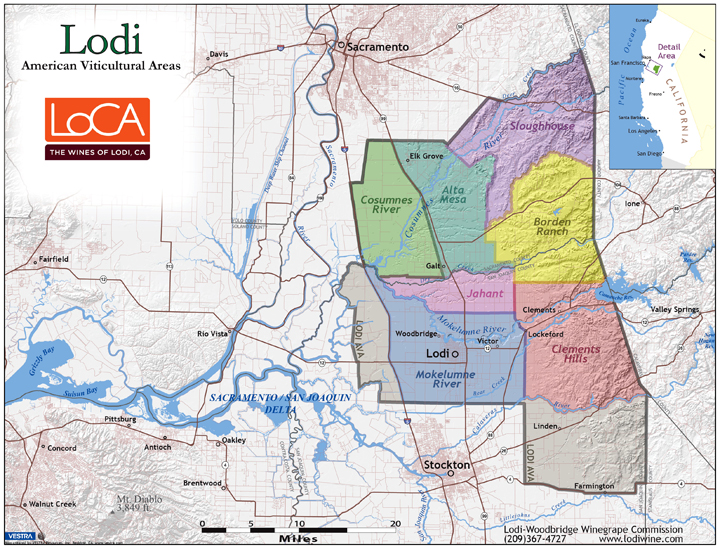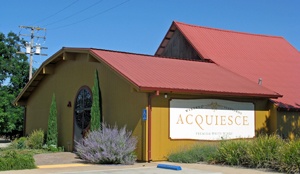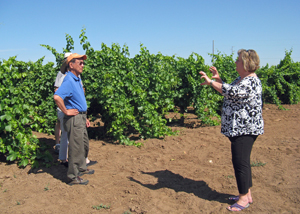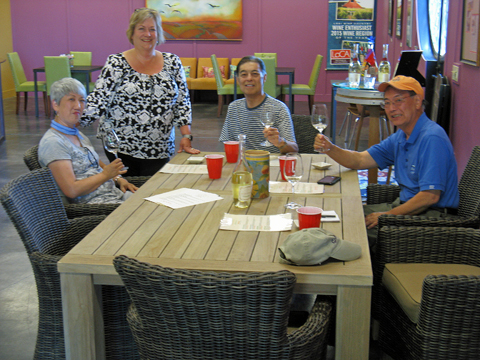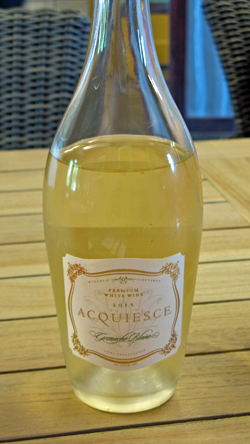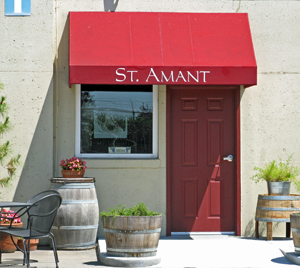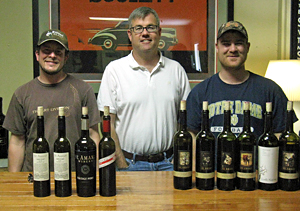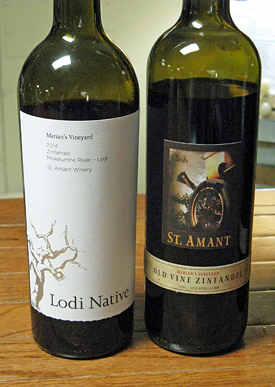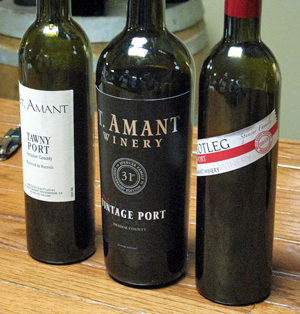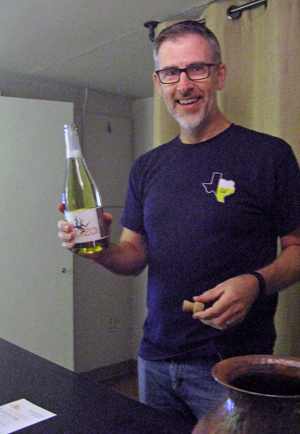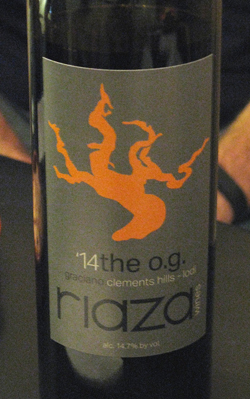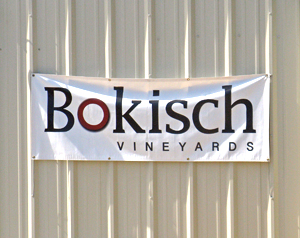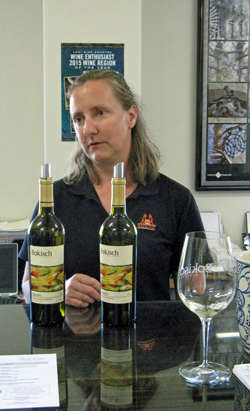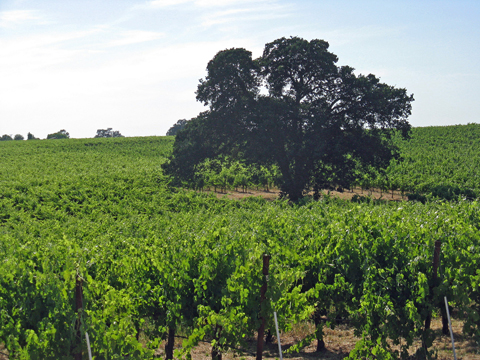Lodi Wine Country - June 2016
I’d been meaning to make the drive from the Bay Area to Lodi again to check out wineries there. So I decided to take off an early June Friday and head out that way, and found a few friends to come along – Jane, Chris, and Russell. I made a few appointments with winemakers about a week beforehand, seeing that the weather forecast was for a bit cooler temperatures on Friday than over the weekend. Of course by the time Friday rolled around, that had all changed and now predictions were that it might get as high as 108 degrees that day!
Lodi has a long history with growing winegrapes. Both table grapes and wine grapes have been grown there since the 1850s. The Flame Tokay grape – not related to similarly-named varieties from Europe – was once synonymous with Lodi grapes. Widely-grown for table grapes but also to make jug and fortified wines, the variety fell out of favor by the 1960s and not many of the old head-trained Tokay vines remain in the area today. Of other grape varieties, Zinfandel has enjoyed the most success in Lodi over the years, and it is old-vine Zin that has had the biggest impact in putting Lodi back on the wine map. There are a tremendous number of other varieties grown in the area as well, many of which are not commonly seen in California – in particular, Spanish and Portuguese varieties seem to thrive there. Lodi was approved as an AVA in 1986, and seven sub-AVAs were approved in 2006: Mokelumne River, Clements Hills, Jahant, Borden Ranch, Cosumnes River, Alta Mesa, and Sloughhouse. Of these, Mokelumne River and Clements Hills have become the best-known.
I should note that several of the wineries in the write-up below specialize in wines made from Spanish grape varieties, and they tend to use the Spanish rather than the more familiar French names for some varieties – for example Garnacha rather than Grenache and Monastrell rather than Mourvèdre. I’ve used the Spanish names for these varieties where those are the names on the wine labels.
On the morning of our wine day-trip, Russell met me in the East Bay and I drove from there, while Jane & Chris drove from their home in Sacramento. We arrived within a few minutes of one another for our first appointment of the day at Acquiesce Winery & Vineyards.
Acquiesce Winery & Vineyards
Tasting Notes: Current Releases |
Acquiesce 2015 Picpoul Blanc, Estate, Lodi. Light straw color, with citrus and tropical fruit aromas. Light, vibrant mouthfeel and a clean, fresh finish, nice.
Acquiesce 2015 Grenache Blanc, Estate, Lodi. Light straw color, showing apple and pear fruit with a floral note on the nose. A bit more weight on the palate than the Picpoul but with bright acidity and a crisp finish.
Acquiesce 2014 Grenache Blanc, Estate, Lodi. Light straw color, with less forward fruit than the 2015 vintage but featuring a stony mineral note and a hint of flowers. Rounder mouthfeel than the previous wine, with a lively texture and finish, nice – shows that these wines can improve with a little bottle age.
Acquiesce 2014 “Belle Blanc,” Estate, Lodi. 45% Grenache Blanc, 45% Roussanne, 10% Viognier. Light color, displaying more tropical fruit on the nose along with fresh herbs, earth, and floral scents. A moderately rich mouthfeel but with lively acidity and a long finish, nice.
Acquiesce 2014 Roussanne, Estate, Lodi. Light color, this had intriguing aromas of flowers, earth, and undertones of hazelnuts along with pear and stone fruit. Medium weight on the palate with a clean finish – tasty now, but this should be a good candidate to cellar for the short-term or perhaps even longer.
Acquiesce 2015 Viognier, Estate, Lodi. Light straw color, showing upfront floral aromas plus apricot and peach fruit. A bit richer mouthfeel but with fine balancing acidity and a lively finish, nice.
Acquiesce 2014 Viognier, Estate, Lodi. Light color, with more toned-down aromatics than the 2015 vintage, and adding an interesting orangepeel note. Medium-bodied with a smooth texture and tingly acidity on the finish.
Acquiesce 2015 Grenache Rosé, Estate, Lodi. Light salmon/pink color, featuring fresh strawberry, spice, and a floral note on the nose. Medium-light bodied, this had zippy acidity and a clean finish, nice.
|
|
This was my first visit to Acquiesce. I’d tried their wines with proprietors Sue and Rodney Tipton at the past two Rhone Rangers tastings and thought they were quite good so this seemed like a perfect opportunity to stop in to see their vineyard and winery. We’d made an appointment for earlier than the Acquiesce tasting room opening time, both to get a little quieter tasting environment and to check out the vineyard before the day got too hot. We couldn’t help but notice the beautiful and distinctive entry door and window at the front of the tasting room – Sue told us that it was made by an ironworker in the nearby town of Walnut Grove. Both Sue and Rodney were in the tasting room when we arrived and they welcomed us inside.
Sue and Rodney are relative newcomers in a region where many winegrape growers are from families that have been farming in the area for generations. Rodney’s business took him to the area after the couple had lived in a number of places before. He headed up a company in the city of Lathrop (about 25 miles south of Lodi) that develops automated warehouses until just a few months ago and he’s now focusing full-time on Acquiesce along with Sue. Even before they moved, Sue and Rodney had thought about finding a spot to grow winegrapes, and they purchased their 18-acre property to the northwest of town in 2003. There were already 12 acres of Zinfandel vines on the property, as well as a century-old hay barn that needed lots of work. Sue worked with the vines, planted in sandy soil, although she had not originally planned to make wine commercially. But between Sue starting to make wine at home and the couple’s shared fondness for the white wines of Châteauneuf-du-Pape, they decided to launch their own label.
Lodi, with its warm climate, has never been particularly known for its white wines, so a plan to focus on white Rhône grape varieties might have seemed a daring choice there, but they’ve made it work surprisingly well. Sue oversaw planting of 4 acres with Picpoul, Grenache Blanc, Viognier, and Roussanne, plus some head-trained Grenache Noir for a rosé. And just last year, 6.5 acres of the Zin vines were taken out and that area was replanted with Clairette, Bourboulenc, plus more Picpoul, Grenache Blanc, and Grenache Noir. The new plantings will probably produce a small crop next year, with the first regular crop coming in 2018. There’s still 5.5 acres of Zin that the Tiptons sell to other local producers.
Clairette and Bourboulenc are fairly new and rare varieties in California – the Tiptons’ vineyard is one of the first in the state to grow them. Sue had intended the initial planting of Picpoul – another variety seldom-seen in California – to go into a blend, since that grape is noted for its high acidity. But she found that the Picpoul makes a fine varietal wine on its own there, so the newer planting will allow some to be used for the original purpose of blending. We asked Sue about Marsanne, since that variety was notably absent from their vineyard, and she told us that she’s never been a big fan plus it has the reputation of being tough to grow. All of the plant material was sourced from Tablas Creek clones that were brought to California from Château de Beaucastel, except that the new Grenache planting is from Alban clone.
Sue’s aim with her winemaking is to produce fresh, crisp wines. The fruit is hand-picked in the early morning, whole-cluster pressed, and the juice is then pumped into variable-volume stainless steel tanks with glycol jackets for individual temperature control. It’s fermented at about 55 degrees – all of the Acquiesce wines are completely dry, and this takes about 30 days. The wines do not go through malolactic fermentation and are kept in stainless steel until bottling – there is no use of oak at all. All the wines are bottled in the January following harvest. Acquiesce has a tasting room that opens in March each year for their new vintage, and generally closes around November when all the wine sells out. Once production starts from their newest planting, Sue hopes to have enough wine to keep the tasting room open year-round. Annual production is around 1,500 cases and plans are for it to top out at about 3,000 after fruit from the new plantings comes online.
Once we’d all gathered in the tasting room with Sue, she asked whether we wanted to start right off with tasting the current Acquiesce releases, but we thought it would be a good idea to take a look at the vineyard first. Sue led us outside to the adjacent vines and showed us the developing clusters on the head-trained Grenache Noir vines. As I’ve noticed in previous trips to Lodi, growers there tend to let the vine canopies grow more than at vineyards in more coastal location, as shading the fruit from the hot summer sun is critical. The canopy still needs to be managed properly to keep growth in balance and to allow for airflow through the fruit zone. We walked back to winery building with Sue, and she showed us the crushpad and tank areas. Much of the winery space shares the refurbished original barn building with the tasting room.
Sue suggested that it might be more comfortable for us to taste at the large table inside the tasting room, and that sounded like an excellent idea. We tasted through the entire line-up of current Acquiesce wines, plus a couple from the previous vintage for comparison. Sue even opened bottles of their 2015 Picpoul and 2015 Grenache Rosé for us to try, even though those two small-production wines are already sold out. All of the wines come from the Tiptons’ estate vineyard fruit, and all are 100% varietal except for the “Belle Blanc” white blend.
We started out with the 2015 Picpoul Blanc – Sue told us that the fruit was picked at about 20 brix, finishing with 12.5% alcohol. Although the Acquiesce rendition of Picpoul is not as sharply acidic as some I’ve tried, it retained a pleasantly zippy mouthfeel and finish. It’s a testament to the quality of fruit that nearly all of the wines are in the range of 13-13.5% alcohol – with just the Viognier being a bit higher – yet they all feature ripe flavors as well as lively acidity. Next was the 2015 Grenache Blanc, and Sue followed that with the 2014 Grenache Blanc for comparison. Both were very good but different, and it although the freshness and crispness of the newest vintage were appealing, the added texture and subtleties of the 2014 showed me that there’s no need to drink these wines right away – try them with a bit of bottle age. Some of the wines we tried were presented with well-considered pairings of cheese with toppings and other tasty small bites – nice accompaniments to the wines and a fine way to enhance the tasting experience.
The “Belle Blanc” blend is inspired by the white wine of Château de Beaucastel, and the 2014 bottling – mostly Grenache Blanc and Roussanne plus a little Viognier – turned out to be my favorite of the tasting, with its subtle aromas, moderately rich mouthfeel and fine acidity. We moved on to compare the 2015 and 2014 vintages of Viognier – unlike the Grenache Blanc comparison, I preferred the younger bottling of this one. It struck me as combining the upfront floral and stone fruit aromatics you get from Viognier grown in warmer climates with the bright, citrusy acidity you find from cooler sites. Our final wine was the 2015 Grenache Rosé, from fruit grown and picked specifically for this wine – very nice way to conclude our tasting.
I have to mention the distinctive bottles that Acquiesce uses for their wines. They’re imported from France and are more expensive than most wine bottles, but they certainly help the Acquiesce wines to stand out in a crowd. Plus, as Sue joked, she shares the same shape as the bottles! One other thing to note is the name of the winery – it’s named for a k.d. lang song that Sue and Rodney had listened to 20 years ago as they were sitting out on the patio of their home in Portland. Rodney predicted that they would one day have a place with lots of land and beautiful views where they could “acquiesce.”
Sue was a terrific host to our group and we all enjoyed our visit to Acquiesce. I remember the first time I came across these wines a couple of years ago, I was surprised that someone would decide to focus on white wines from Lodi. But considering how crisp and delicious the wines turned out to be – and seeing how well they’ve sold – I’ve learned that the choice that Sue and Rodney made was a smart one indeed. Their wines have garnered some impressive awards at recent major wine competitions – their 2015 Viognier won “Best Viognier” at the 2016 California State Fair Commercial Wine Competition, and their 2015 Grenache Blanc won “Best in Class” in Sunset Magazine’s 2016 International Wine Competition. My favorites of the wines we tasted were the 2015 Picpoul Blanc, 2014 Grenache Blanc, 2014 “Belle Blanc,” 2015 Viognier, and 2015 Grenache Rosé. That’s a lot of favorites out of a total of eight wines but they were that good! The Picpoul and the Rosé are already sold out, so it would be wise to look for the others before they sell out as well. Acquiesce has set itself apart by the bottles they use but more importantly by the wine that goes into those bottles. This is a distinctive Lodi winery that’s well worth checking out.
St. Amant
Tasting Notes: Current Releases |
St. Amant 2015 Verdelho, “Miss Independent,” Amador County. Made entirely in stainless steel. Light color, with citrus and pear aromas along with herbal and mineral notes. Medium-light bodied with bright acidity and a clean finish, nice.
St. Amant 2014 Barbera Rosé, Lodi. Sourced from a 40-year old vineyard, made in older oak. Light pink color, this displayed cranberry and strawberry fruit plus a hint of spice on the nose. Medium-light weight and lively on the palate and a slightly chalky note on the finish.
St. Amant 2012 Trousseau, “The Little Bastardo,” Amador County. Medium-light color, showing ripe plum, spice, and vanilla/oak aromas. Medium-bodied with a smoother texture and finish, and moderate tannins.
St. Amant 2014 Touriga, “The Old Soldier,” Amador County. Medium purple color, with lots of spice and pepper on the nose, plus plum and darker fruit and a dash of sweet oak. Medium weight with moderate acidity and fairly refined tannins, nice.
St. Amant 2014 Barbera, “Tools of the Trade,” Lodi. Sourced from a 40-year old vineyard. Medium color, with ripe black cherry, dried herbs, and spice aromas. Medium-bodied with bright acidity and a slightly tangy finish with moderate tannins.
St. Amant 2014 Zinfandel, “Old Vine,” Mohr-Fry Ranch, Lodi. Sourced from head-trained vines planted from 1901 to 1945, aged in 20% new American oak. Medium purple, this featured lots of upfront berry and plum fruit, spice, and notes of smoke and vanilla/oak. Medium-bodied with a lively texture, finishing with moderate tannins.
St. Amant 2014 Zinfandel, “Old Vine,” Marian’s Vineyard, Lodi. Sourced from head-trained vines planted in 1901, aged in 20% new French oak. Slightly darker color than the Mohr-Fry Zin, with less forward fruit but more earth, black pepper, and spice, with touches of dried herbs and sweet oak. Medium weight on the palate with bright acidity and firmer tannins than the previous wine, nice.
Lodi Native 2014 Zinfandel, Marian’s Vineyard, St. Amant Winery, Mokelumne River-Lodi. Sourced from head-trained vines planted in 1901, aged in neutral oak. Medium color, showing a more bright red-fruited profile, with raspberry and black cherry notes, lots of pepper, and hints of earth and spice. Vibrant texture with bigger structure and grippier tannins – a distinctive wine with great promise that deserves time in the cellar.
St. Amant 2013 Cabernet Sauvignon, Lloyd Martel Vineyard, Lodi. Medium-dark purple, with bright plummy fruit, plenty of black pepper, dried herbs, and sweet oak on the nose. Medium-full bodied with a chewy tannic finish, needs time to settle down.
St. Amant 2014 Tempranillo, “The Road Less Traveled,” Amador County. Aged in French and American oak, 25% new. Medium purple color, this showed more upfront vanilla/oak aromas along with plum and darker berry fruit, earth, smoke, and spice. Big and structured, finishing with grippy tannins – shows good potential for aging.
St. Amant 2014 Souzão, Amador County. Aged in French and American oak, 20% new. Medium-dark color, displaying tart black cherry fruit, spice, earth, and a touch of sweet oak. Medium-full bodied with fine acidity, this had firm tannins on the finish.
St. Amant 2013 Syrah, “The Curmudgeon,” Amador County. Aged in French and American oak, 20% new. Medium-dark purple, with a darker fruit profile, black pepper, hints of flowers and herbs plus a dash of vanilla/oak. Medium weight with a lively texture and good structure, finishing with bigger but refined tannins, nice.
St. Amant 2013 “Bootleg Port,” Amador County. From Touriga Nacional, Touriga Franca, Tinta Roriz, Tinta Cão, Souzão, and Bastardo, aged in neutral oak. Medium-dark color, this had ripe plummy fruit along with chocolate and clove-like spice on the nose. Rich mouthfeel with fine tannins on the smooth finish.
St. Amant 2012 Vintage Port, Amador County. From Touriga Nacional, Touriga Franca, Tinta Roriz, Tinta Cão, Souzão, and Bastardo, aged in neutral oak. Similar character to the “Bootleg” bottling but with less upfront fruit and more spice and chocolate aromas along with touches of pepper and earth. Rich yet lively on the palate, with a long finish, nice.
St. Amant NV Tawny Port, “Lot #7,” Amador County. Mostly Bastardo plus some of the other Port grape varieties, aged in neutral oak, bottled in March 2014. Medium-light garnet color, featuring plum, caramel, pecans, and brown sugar aromas. Fairly sweet and rich, with firm but refined tannins on the finish, nice.
St. Amant NV Tawny Port, “Lot #8,” Amador County. Mostly Bastardo plus some of the other Port grape varieties, aged in neutral oak, bottled in March 2015. Similar profile to the “Lot #7” but with a little more fruit and a bit less of the nutty and caramel components. Rich, sweet, but lively, with a long smooth finish.
|
|
I’ve been sure to stop at St. Amant nearly every time I’ve visited Lodi wineries. I’ve enjoyed their wines both at their tasting room and at the annual Tempranillo Advocates, Producers, and Amigos Society (TAPAS) events in San Francisco. Wines made from Iberian grape varieties are a specialty of St. Amant, but they make other very good wines as well. Another reason I wanted to visit St. Amant on this trip is that I remembered their tasting room cat – my friend Jane loves cats so I was hoping we’d get a chance to see St. Amant’s. I’d contacted winemaker Stuart Spencer about a visit, and he told me he would be busy for most of the morning we’d be in the area but he would arrange for us to have a nice tasting there. He said he might see us before we finished up, too.
St. Amant’s winery and tasting room are located in a small portion of the enormous old Guild Wines building on the east side of Lodi. This had been the blending, aging, and bottling plant for a group of co-operative producers called the Wine Growers Guild. In the mid-1900s, Guild Wines was one of the largest wine brands in the country.
|
| l to r: Joel, Stuart, Nathan, at St. Amant |
St. Amant was founded by Tim and Barbara Spencer, and the winery name comes from Barbara’s maiden name. The Spencers had planted a 43-acre vineyard in 1972 on their property in the Jackson Valley area of Amador County, about 30 miles northeast of Lodi. This was originally planted to Zinfandel and Sauvignon Blanc, which they sold to local wineries. In 1979 they grafted two acres of their Zin vines over to five Portuguese grape varieties – Touriga (both Nacional and Franca), Tinta Cão, Alvarelhão, Bastardo, and Souzão. There are now a few other varieties planted there as well, including Verdelho, Tempranillo, Syrah, and Cabernet Sauvignon. Their first wine was a traditional Port made from this fruit in 1981, and St. Amant continues to make fine Port-style wines. The Spencers moved their winery from Amador County to Lodi in 1996, though much of their fruit is still sourced from their Amador vineyard, which was replanted in the 1990s due to phylloxera. They also buy Zinfandel and Barbera fruit from Lodi. Tim Spencer passed away in 2006, and the winery is now run by Barbara and their son Stuart. St. Amant currently makes about 20 different bottlings, with a total annual production of around 7,000 cases.
As we parked in front of the winery building in the late morning, I checked the outside temperature gauge in my car, and it was already up to the mid-90s. Glad to head inside on a day like that! As we walked toward the tasting room door, assistant winemaker Joel Ohmart greeted us – he said that Stuart had told him we’d be coming and that he and cellar hand Nathan Haberkern would pour some wines for us inside. The tasting area is at a counter in a corner of a large room with barrels, cases of bottled wine, and various wine displays. Joel got us started on the tasting, but as he needed to attend to some other work at the winery, he handed us off to Nathan partway through.
We began with the lone white wine of the tasting, a bright and minerally 2015 Verdelho sourced from the Spencers’ Amador vineyard and made entirely in stainless steel with no malolactic fermentation. I’ve enjoyed St. Amant’s Verdelho in past vintages and the new one was just as good. We followed that with a 2014 Barbera Rosé made in a Vin Gris style, pressed after about 24 hours on the skins and fermented in older oak and stainless steel.
We continued with the first of many red wines – as we tasted, Nathan brought out a few that weren’t originally on the counter when we started, so we went through a lot of them by the time we were done. He noted that some of these additional wines might not have been presented in the ideal order, but we didn’t have any problem – it all worked out fine! Our first red was 2012 Trousseau, St. Amant’s first bottling of this variety as a dry red, though they’ve worked with it for many years in their Port-style wines under its Portuguese name of Bastardo. Since Bastardo is not an approved name for the variety yet in the US, they went with the French version. A spicy, peppery 2014 Touriga and a bright and slightly herbal 2014 Barbera followed – the Barbera came from 40+ year-old vines in the Lodi area. There’s not a lot of new oak used in the St. Amant reds – generally around 20% for most – and both French and American oak barrels are used, depending on the wine. The wines have modest alcohol by Lodi standards, with most reds right around 14.5% and one or two coming in under 14%.
In addition to its wines from Spanish and Portuguese grape varieties, St. Amant is well-known for its old-vine Zinfandels, among the best I’ve tried in Lodi. We tasted three 2014 Zins made by the winery. Their Mohr-Fry Ranch Zinfandel came from own-rooted, head-pruned vines planted between 1901 and 1945, sourced from three or four of the eight blocks of old-vine Zin there. The vineyard is about 240 acres – big but not really large for Lodi – and their Zinfandel fruit had been sold to larger producers such as Gallo before St. Amant began buying it. The first St. Amant bottling came in 1996 when Jerry Fry was able to help out the Spencers with eight tons of fruit after the Zin vines at their Amador vineyard were hit by phylloxera. The Marian’s Vineyard Zinfandel comes from a single block at Mohr-Fry Ranch, about eight acres planted in 1901 – Jerry named the vineyard in honor of his mother Marian Mohr Fry Zimmerman, who passed away in 2007 at the age of 94. The Mohr-Fry bottling was aged in 20% new American oak that took a back seat to the upfront Zin fruit, while the Marian’s Vineyard Zin was aged in 20% new French oak, and displayed less upfront fruit but more spice and earth notes.
The third Zinfandel we tasted was part of a fairly new program called “Lodi Native.” This is a collaborative project among a number of vintners to highlight Zin grown in some of the area’s older vineyards. Based on an idea by wine writer Randy Caparoso, each vintner makes their old-vine Zinfandel according to a set of guidelines meant to showcase the distinctive vineyard qualities rather than the winemaking. The wines must be 100% Zinfandel, with no inoculated fermentations and no additions of water, acid, etc., no new oak, no fining or filtering, and a few other similar restrictions. The Lodi Native Zinfandels have been available only in a boxed set of wines from all the vintners – there have been six wines for the first two vintages, 2012 and 2013, and it sounds like there may be more for the new 2014 release. Nathan generously opened a bottle of the new 2014 St. Amant Lodi Native Zinfandel, from Marian’s Vineyard. The differences from the regular St. Amant Marian’s Zin were fascinating – both were terrific but highlighted different aspects of the wine, with the Lodi Native bottling displaying brighter fruit and bigger structure.
Those Zins were a tough act to follow but we continued with some other very good wines. We tasted a 2013 Cabernet Sauvignon from Lodi’s Lloyd Martel Vineyard, and then a 2014 Tempranillo from the Spencers’ Amador vineyard, bottled recently and aged in a little more new oak than in the past, about 25%. St. Amant is one of the very few wineries in California to bottle a varietal Souzão, also sourced from the Spencers’ vineyard – the 2014 we tasted is their fifth vintage of this wine. We finished up the last of the dry reds with a 2014 Syrah, also from the Amador site. A little Tempranillo (2-5%) is blended with the Syrah, as well as with the Barbera and Souzão.
We’d tasted a dozen wines, but we weren’t done yet! St. Amant is highly-regarded for their Port-style wines, and we tried four of them to wrap up our tasting. All of these wines are aged in neutral oak. The 2013 “Bootleg Port” uses six traditional Port varieties from the Spencers’ vineyard in Amador – Touriga Nacional, Tinta Roriz, Touriga Franca, Tinta Cão, Souzão, and Bastardo. The 2012 Vintage Port is a barrel selection from the “Bootleg Port”, using the same grape varieties – St. Amant only bottles a Vintage Port on average about once every 3 years. Our last two wines were the most recent bottlings of their Tawny Port. The “Lot #7” Tawny was bottled in March 2014, while the “Lot #8” was bottled in March 2015 – both are about 2/3 Bastardo and about 1/3 a blend of all the Port varieties. These barrels are not topped or racked until they’re prepared for bottling. St. Amant’s Tawny is a consistent favorite – I can’t help but think how well it would go with pecan pie!
St. Amant also produces a few other wines, including a blend called “Speakeasy Red” (mostly Zinfandel and Barbera plus Souzão, Tempranillo, and others) and a late-harvest Barbera. We ended up tasting 16 wines during our visit, nearly all of St. Amant’s current releases. I learned not long after our visit that their 2014 “The Road Less Traveled” Tempranillo won “Best of Show Red” at the 2016 California State Fair Commercial Wine Competition – quite an honor. Shortly before we finished up our tasting, Stuart got back to the winery and we had a nice talk with him before we took off. Joel and Nathan were terrific hosts, both enthusiastic and knowledgeable about the vineyards and wines. And as we were winding down our visit, Jane finally did get to meet Calico, the St. Amant cat!
I’ve always enjoyed my visits to the St. Amant tasting room. You can feel a little bit of Lodi wine history being inside part of the old Guild Wines building. And the wines have been very solid over the years, with some notable standouts. On this visit, the 2015 Verdelho, 2014 Touriga, 2014 Marian’s Vineyard Zinfandel, 2013 Syrah, 2012 Vintage Port, and “Lot #7” Tawny Port were my favorites, as well as the 2014 Lodi Native Marian’s Vineyard Zin. In comparison with some other wines from the area, St. Amant’s wines show ripeness with restraint rather than a noticeable sweetness. St. Amant seems to be one of those wineries that flies below the radar, but they’re making consistently good wines, certainly among the best I’ve tried from Lodi.
We were ready for lunch by the time we finished up our tasting at St. Amant, and I suggested the Lodi Beer Company as an option since I’d eaten there before. Located on School Street in downtown Lodi, the pub-style fare is nothing really out of the ordinary but well-prepared and tasty – Chris mentioned that he especially enjoyed his fish & chips. There’s a nice selection of their own brews on tap, including some seasonal selections. Oddly, I was the only one who had a beer with lunch – hey, it’s a brewpub, people!
Riaza Wines
Tasting Notes: Current Releases |
Riaza 2014 Sparkling Verdejo, Heringer-Holland Vineyard, Clarksburg. 100% Verdejo. Light straw color, with ripe stone fruit and herb aromas. Lighter-bodied with fairly fine bubbles, bright acidity, and a slightly sweet finish – should be a fun summertime sparkler.
Riaza 2015 “elemental,” Clarksburg. 92% Verdejo, 8% Chardonnay, made in stainless steel. Light color, this had stone fruit and pear on the nose along with hints of flowers and spice. Medium-light weight, with bright acidity and a crisp finish.
Riaza 2015 Garnacha Rosé, “irreverent,” Clements Hills-Lodi. 94% Grenache, 6% Zinfandel, made in stainless steel. Light salmon/pink color, displaying watermelon, lots of spice, and hints of fresh herbs. Lighter-bodied with a refreshing mouthfeel and finish.
Riaza 2013 Carignane, “old soul,” Kaden-Gene Vineyard, Mokelumne River-Lodi. 100% Carignane. Lighter color, this featured bright strawberry aromas plus earth, spice, and a touch of pepper. Medium-light bodied with a lively texture and mild tannins, nice.
Riaza 2013 Monastrell, “prospector,” Cobb Vineyard, Amador County. 100% Monastrell, aged in French and American oak. Medium purple, with plum and black cherry fruit, earth, smoke, and spice on the nose. Medium weight with nice acidity, this finished with firm but refined tannins, nice now and should age well too.
Riaza 2013 Tempranillo, “outsider,” California. 100% Tempranillo, aged in French and American oak. Medium purple color, this showed bright plum and darker berry fruit, earth, spice, a stony mineral note, and a touch of vanilla/oak. Medium-full bodied with a structured mouthfeel and moderate tannins – this needs more time but shows potential.
Riaza 2013 Zinfandel, “the standard,” Clements Hills-Lodi. 100% Zinfandel, aged in French and American oak. Medium color, with lots of upfront spice along with blueberry, earth, and pepper notes. Medium weight with enough structure for mid-term aging.
Riaza 2014 Graciano, “the o.g.,” Clements Hills-Lodi. 100% Graciano, aged in French oak. Medium-dark color, with the earthy and somewhat funky character of this variety, along with savory herb and dark berry aromas. Fairly big and structured, with a firm tannic finish – an intriguing young wine that has good aging potential.
|
|
Our next stop was also in downtown Lodi, at the tasting room of Riaza Wines. I’d tasted a number of wines from Riaza at the Tempranillo Advocates, Producers, and Amigos Society (TAPAS) tastings in San Francisco in recent years and thought they were among the better ones being poured there. We were happy to head into the tasting room from the heat of the afternoon, and Riaza owner/winemaker Rick Taylor greeted us as we stepped inside. Rick had set up a spot for us at a private table just beyond the main tasting bar, and we all had a seat around it.
Rick and his wife Erin established Riaza in 2008, and they specialize in wines from Spanish grape varieties. Rick is originally from Ohio, and he told us that he didn’t even drink wine when he moved to Sacramento for work, though once he was there he checked out some wineries in the area. Erin grew up in Stockton – she now works as regional manager for PepsiCo. – and was more familiar with wine. After she and Rick met, they found themselves spending time learning more about wine and visiting wineries. It was when the couple traveled to Spain that they fell for Spanish wines – the Riaza name comes from a small town north of Madrid that Rick and Erin visited and that helped inspire them to launch their own winery. Rick started helping out at local wineries as well as with Dave Corey of Core Wines in Santa Barbara County. Since Rick was spending so much time with his new wine hobby, in 2008 a friend asked why not start his own winery…the beginning of a slippery slope!
That first year Rick made a small amount of Garnacha, Tempranillo, and Graciano, while 2010 was the first commercial vintage for Riaza. The winemaking facility is close to town, just east of Highway 99. Rick and Erin opened their downtown tasting room in 2012, and Rick has been committed to the winery full-time for the past two years. The total production has grown to about 1,500 cases per year, and Rick told us that he wants to keep it a small, hands-on operation.
Rick sources fruit from a variety of vineyard sources, mainly from sites in Lodi, Clarksburg, and the Sierra Foothills. Some of the Lodi vineyards are farmed by noted grower Markus Bokisch, while much of the Clarksburg fruit comes from Heringer-Holland Vineyard, one of the most highly-regarded vineyards in that region. Rick gets fruit from both El Dorado and Amador counties in the Sierra Foothills. Fruit is picked on the earlier side compared with many Lodi wineries, resulting in wines that are dry and moderate in alcohol – reds are mostly in the mid-14% range while whites are below 12%. Winemaking is straightforward, and red wines are typically aged for about 18 months in oak, with an average of 2-3 year-old barrels. Rick uses both French and American oak, and he finds that some varieties work better with one or the other – for example the Tempranillo does well in American oak while Garnacha works better in French.
Rick started us out on our tasting with Riaza’s first sparkling wine, a 2014 Sparkling Verdejo from Heringer-Holland Vineyard in Clarksburg. Quite a few smaller wineries “farm out” their sparkling wine production since it requires a very specialized form of winemaking, and Rick and Erin had theirs made by noted sparkling producer Weibel. Rick told us that their slightly sweet Sparkling Verdejo was inspired more by Prosecco than by other sparkling styles. Next was a 2015 Verdejo-based blend called “elemental” and sourced from two Clarksburg vineyards. Rick noted that the Chardonnay component works particularly well with the Verdejo. Rick first made this blend in 2013, and co-fermented the two varieties for first time in 2015 – the wine is made in stainless steel, helping to give it a bright, fresh character. Before moving on to reds, we tasted Riaza’s first rosé wine, called “irreverent.” It’s mostly Garnacha, along with a little Zinfandel, and the fruit was pressed after spending a day on the skins, then fermented and aged in stainless steel.
Our first red was the 2013 “old soul” Carignane, from the Kaden-Gene vineyard on west side of Lodi. Rick helps farm this site, which has Carignane vines planted about 80 years ago. The “old soul” highlighted the brighter red-fruited side of the grape variety. The 2013 “prospector” Monastrell came from Cobb Vineyard in Amador County – previously part of the old Karly property, Turley now makes a vineyard-designate Zin from there. Rick feels that Monastrell does better at higher-elevation sites, and it’s notable that these vines are about 40 years old and head-trained. Rick was only able to get this fruit in 2013 – he told us that his Monastrell from 2014 and 2015 were sourced from Calaveras County, while this year’s will come from Amador.
The 2013 “outsider” Tempranillo is sourced from 1/3 each Heringer-Holland (Clarksburg), Hunter’s Oak (Lodi), and Firefall (El Dorado) vineyards. Rick had previously made separate single-vineyard bottlings for the Riaza Tempranillo, but found that they worked well blended together. Next up was 2013 “the standard,” Riaza’s first Zinfandel – even if you specialize in Spanish grape varieties, it seems like you’re almost required to make a Zin if you’re in Lodi! Aged in about 60% American and 40% French oak, this one was more restrained than many Lodi Zins but still showed the identifiable character of the region. We finished with a wine club-only wine, a 2014 Graciano called “the o.g.” – 100% varietal, this was a fine way to end our tasting at Riaza.
In addition to the wines we tried, Riaza also makes a Garnacha called “illusion” and a Graciano-based “diablo rojo” red blend that also includes Tempranillo, Sangiovese, Alicante Bouchet, and Zinfandel. The fruit for the “diablo rojo” blend is sourced from both Lodi and from Amador County. I noticed during the tasting that some wines were under screwcap and asked Rick about that. He told us that they are bottling their wines entirely under screwcap starting with the 2014 reds and 2015 whites and rosé. As with some other wineries, issues with corked wines have led Rick and Erin to make this switch.
We had a good time tasting the Riaza wines with Rick. Even though he didn’t grow up with wine in Ohio, he’s clearly enthusiastic about wine these days, and lots of fun to talk with. Though it’s a small and newer venture in a region that’s seen a lot of wineries open in the past 10-15 years, Riaza from the start moved into a distinctive niche by specializing in wines made from Iberian grape varieties, something it shares with only a few wineries in Lodi. And Rick has set Riaza apart as well by making all his wines – except for the sparkler – quite dry in an area where wines with a touch (or more) of residual sugar are fairly common. While I get the sense that Rick is still fine-tuning both his fruit sources and his winemaking regimen, the Riaza wines I’ve tried so far have been solid overall – that’s why I wanted to visit there, after all! – and things look to be moving in a good direction. The wines continue to be very good across the board, with the 2015 “old soul” Carignane, 2013 “prospector” Monastrell, and 2014 “the o.g.” Graciano being standouts at our tasting, and the 2015 “elemental” white blend and 2013 “outsider” Tempranillo just a notch below those three. With its tasting room located close to lots of places to eat and shop in downtown Lodi, Riaza is a convenient place to stop to taste some distinctive wines.
Bokisch Winery & Vineyards
Tasting Notes: Current Releases |
Bokisch 2014 Albariño, Terra Alta Vineyard, Clements Hills-Lodi. 100% Albariño, made entirely in stainless steel. Light straw color, this had pear and citrus aromas along with a hint of flowers. Medium-light weight with a lively texture and crisp finish.
Bokisch 2015 Albariño, Andrus Island Vineyard, Sacramento County. 100% Albariño, made entirely in stainless steel. Light color, with a more tropical fruit profile plus herbal undertones. Medium-light bodied, with a fairly smooth finish.
Bokisch 2015 Albariño, Las Cerezas Vineyard, Mokelumne River-Lodi. 100% Albariño, made in stainless steel and neutral oak. Light straw color, featuring less forward apple and citrus fruit, earth, orangepeel, and a saline note. A bit more texture and weight on the palate than the previous two wines, with a clean and lively finish, nice.
Bokisch 2014 Verdejo, Clay Station Vineyard, Borden Ranch-Lodi. 100% Verdejo, made entirely in stainless steel. Light color, this showed pear, stone fruit, and herb notes on the nose. Medium-light weight with a slightly chalky texture and bright finish.
Bokisch 2014 Garnacha Blanca, Vista Luna Vineyard, Borden Ranch-Lodi. 100% Garnacha Blanca, made mostly in stainless steel plus a little neutral oak. Light straw color, displaying ripe stone fruit and tropical fruit plus hints of flowers and spice. Slightly richer mouthfeel, with a long, smooth finish.
Bokisch 2015 Rosado, Terra Alta Vineyard, Clements Hills-Lodi. From 99% Garnacha, 1% Graciano, made in stainless steel and neutral oak. Light salmon color, this had aromas of watermelon, fresh herbs, and earth. Medium-light bodied with vibrant acidity and a clean finish, nice.
Bokisch 2011 Monastrell, Belle Colline Vineyard, Clements Hills-Lodi. 90% Monastrell, 5% Garnacha, 5% Graciano, aged 18 months in French and American oak. Medium purple color, with spice, plum and darker fruit, earth, and herbs on the nose. Medium-bodied with good acidity and refined tannins – this is developing nicely with a couple of years of bottle age.
Bokisch 2013 Tempranillo, Lodi. 85% Tempranillo, 15% Graciano, sourced from Liberty Oaks & Las Cerezas Vineyards, aged 18 months in about 25% new French and American oak. Medium-dark color, this featured black cherry and plum fruit, smoke, spice, and a touch of sweet oak aromas. Medium-full bodied with good structure for aging and a firm tannic finish.
Tizona 2013 Zinfandel, “Old Vine,” Kirschenmann Vineyard, Lodi. 100% Zinfandel, aged 20 months in neutral oak. Medium-light color, showing lots of upfront spice along with black cherry and raspberry fruit plus a brushy, earthy note. Medium weight with a lively texture and moderate tannin, nice.
Bokisch 2012 Graciano, Lodi. 98% Graciano, 2% Tempranillo, sourced from Las Cerezas & Terra Alta vineyards, aged 18 months in French and American oak. Medium-dark purple, with earth, darker berry fruit, dried herbs, and plenty of spice on the nose. Fairly big and structured on the palate, with firm tannins on the finish.
Tizona 2014 Late Harvest Graciano, Terra Alta Vineyard, Clements Hills-Lodi. 16.9% alcohol, 4.5% residual sugar, aged in neutral oak. Medium-dark color, this featured ripe black cherry and plum fruit, chocolate, spice, and an herbal note. Rich but not overly sweet, this had good structure and a long finish.
|
|
Our final stop of the day was at Bokisch Vineyards. Located a few miles east of Lodi near the small town of Lockeford, the tasting room adjacent to the winery space just opened in February. I visited with winery owners Markus & Liz Bokisch back in 2008 at their home and adjacent Las Cerezas Vineyard, and I’ve tasted their wines for a number of years at various events. And I’ve known Bokisch winemaker Elyse Egan Perry and her husband Jeff for a number of years as well, ever since Elyse got her start in the wine business as a harvest intern for noted winemaker Ed Kurtzman. Bokisch been one of California’s leading producers of wines made from Spanish and Portuguese grape varieties over the years.
Markus spent summers staying with his grandmother and family in Catalonia when he was growing up, and he was introduced to Spanish wine there. He and Liz met while they were studying at UC Davis in the late 1980s, and Markus went on to work at Joseph Phelps before he and Liz moved to Spain for 1½ years while Markus worked in the wine business there. They returned to California and purchased land in both the Mokelumne River and Clements Hills regions of Lodi. They planted vineyards in both areas beginning in 1999 and produced the first wines under their Bokisch label in 2001. Elyse came on board in late 2013, and she was promoted to winemaker early this year. Jeff is the tasting room manager for the winery. Elyse also has her own small Egan Cellars label that she launched in 2011. Elyse told us that the Egan label is on hiatus but will return – she’s planning to make Picpoul and a Rhône-style red blend from Lodi and Barbera from Clarksburg. Total annual production for Bokisch is around 5,000 cases, with most being Albariño and Tempranillo, and production is expected to increase to about 6,000 cases in 2016.
The cuttings for plantings at the Bokischs’ own vineyards came from Spain, so many of their clonal selections are different than most in California. Their own vineyards are all farmed organically, and include Albariño, Verdelho, Verdejo, Garnacha Blanca, Tempranillo, Garnacha, Graciano, and Monastrell among other varieties. Las Cerezas Vineyard next to the Bokischs’ home and close to the Mokelumne River, is on silty loam soil and is planted to Albariño, Tempranillo, and Graciano. Terra Alta Vineyard, adjacent to the winery and tasting room, has volcanic clay loam soil and is planted to Albariño, Picpoul, Viognier, Chardonnay, Garnacha, Graciano, Syrah, and Merlot. Markus also farms over 2,000 acres of other vineyards in the area for the Bokisch Ranches business, founded in 1996. These vineyards are all farmed sustainably and Certified Green under the Lodi Rules program. Lodi Rules is a holistic system that includes provisions for utilizing alternative energy and fuel sources, specific air, water, and soil quality control measures, and for improved human resources / labor relations. Bokisch Ranches currently sells fruit to about 50 producers, a few of which are larger ones though most are smaller artisan wineries.
Markus & Liz had made their wine at other facilities through the years, but they built their own winery and moved in just in time for the 2014 crush. There’s a beautiful view from the winery and tasting room out over the Bokischs’ adjacent Terra Alta Vineyard to the west. Hold on…a view, in Lodi? Yes, Lodi is not all completely flat, as the name of the Terra Alta’s AVA reveals – Clements Hills. Indeed, the landscape in the Lodi region changes noticeably as you drive just a few miles east from town and into the low rolling hills.
Elyse and Jeff both welcomed us into the tasting room, and it was a pleasant surprise to see Liz Bokisch there as well, as I hadn’t expected her to be there. Liz had to attend to other matters so she couldn’t stay to chat with us for long, but Elyse showed everyone part of the winery, easily seen through large windows from the tasting room. We learned that the space we were in used to house the Bokischs’ agricultural equipment before it was converted into their tasting room.
After a few minutes, Elyse got behind the tasting counter and started us out with not one, but three different bottlings of Albariño. Why so many? As we found out, they’re all quite different from one another. The 2014 Terra Alta Vineyard and 2015 Andrus Island Vineyard bottlings were both made entirely in stainless steel, while the 2015 Las Cerezas Vineyard Albariño was made in 60% stainless steel and 40% neutral oak. The Andrus Island bottling is a new one for Bokisch – it’s from a site below sea level in the Sacramento River delta northwest of Lodi, planted in silty loam and peat soil. The Las Cerezas Albariño was my favorite of the three, with more texture to go with the crisp acidity plus an intriguing note of salinity.
Two more white wines followed, beginning with 2014 Verdejo. Elyse mentioned how Verdejo is often confused with Verdelho, another Iberian white variety with a similar name. And to make it even more confusing, Bokisch grows and makes wine from both varieties! We also tasted a 2014 Garnacha Blanca from Vista Luna Vineyard. The Verdejo was made in 100% stainless steel while the Garnacha Blanca includes 7% made in neutral oak. Before moving on to reds, we tried the bright and juicy 2015 Rosado, made in a dry rosé style from Garnacha with a splash of Graciano, fermented and aged in 50% each stainless steel and neutral oak, and only 12% alcohol. Most of the whites and Rosado ranged from 12.0 to 13.5% alcohol (the Garnacha Blanca is a little higher) with fine acidity across the board.
The most recent release of Monastrell (2013) is already sold out, but the winery was able to find a few cases of the 2011 vintage to pour at the tasting room. Sourced from Belle Colline Vineyard, this has been a favorite over the years but unfortunately new vineyard owners there decided to take out the Monastrell, so 2014 will be the last from that site, and Bokisch did not make a Monastrell in 2015. Some good news, though – Markus planted Monastrell at a new vineyard called Sheldon Hills, and the winery will be making it from that site starting this year. The 2013 Tempranillo combines fruit from Liberty Oaks and Las Cerezas vineyards, as has been the case for a number of years, but Elyse told us that they will probably bottle Tempranillo from each site as separate vineyard designates starting with 2015. There’s about 25% new oak for the Tempranillo, with both French and American barrels and with some Eastern European oak as well starting with the 2014 vintage. In general, I’ve found the use of American oak at Bokisch to be very restrained – it does not stand out like it sometimes can do. Red wines typically spend about 18 months in barrel prior to bottling, and they tend to be in the vicinity of 14.5% alcohol.
|
| Bokisch's Terra Alta Vineyard |
Our next wine was a 2013 Zinfandel – if you’re making wine in Lodi, you must make a Zin! This wine comes out under the Tizona label – named for the legendary sword of El Cid – which Bokisch uses mainly for their wines from non-Iberian grape varieties. The Zinfandel was sourced from Kirschenmann Vineyard, owned by Turley winemaker Tegan Passalacqua and his wife Olivia, and planted with own-rooted vines in 1915. The wine was aged for 20 months in neutral oak – drier and more elegant than many Lodi Zins, it shows its old-vine heritage well. Elyse told us that they’re now getting Zin from another vineyard as well, informally called Highway 88 Vineyard. In addition to Zinfandel, there’s also a wine club-only Malbec bottled under the Tizona label.
One more Bokisch red followed – an earthy and spicy 2012 Graciano – and we finished our tasting with another Tizona wine, a 2014 Late Harvest Graciano. This wine was first made almost by chance, when some of the Graciano fruit reached higher brix before being picked, but it turned out so well that they will probably continue to make a little each year. It’s made in neutral oak, moderately sweet (4.5% residual sugar) but balanced by good natural acidity despite the high brix of the grapes. Bokisch wines we didn’t taste on this visit include Verdelho and Garnacha. Elyse told us that they’ll have a new small-production wine coming up, a blend called “Trencadis” that includes Tempranillo, Graciano, and Petit Verdot.
After we finished tasting, we stepped outside with Elyse to a picnic area overlooking Terra Alta Vineyard. Even with the 100-degree heat, under the shade of a large tree it was surprisingly comfortable…at least for awhile. Soon enough, we were all glad to head back into the cool tasting room where we concluded our visit with Elyse and Jeff. Both of them were great hosts – knowledgeable and engaging.
It was fun to see the new Bokisch tasting room and to talk with Elyse, Jeff, and Liz. This is about as scenic a spot for a tasting room as you’ll find in Lodi, and the wines are as good as any you’ll find from the region. I’ve mentioned before that I always find beautifully fresh aromatics from the Bokisch wines – you might not expect that from such a warm climate, but their farming and the winemaking both serve to retain that fresh character in the wines. Favorites on this visit included the 2015 Las Cerezas Albariño, 2014 Verdejo, 2015 Rosado, 2011 Monastrell, Tizona 2013 Zinfandel, with the 2014 Terra Alta Albariño and 2013 Tempranillo close behind. Bokisch continues to be among the very top wineries in Lodi, and a stop at their new tasting room is highly recommended.
This was the first time in a few years that I’d spent a day wine-tasting in Lodi, and it showed me that I need to do it more often. Each time I’m there, I hear about more wineries that sound like they’d be worth visiting, and I need to find the time to check them out. I had a couple of other possibilities to add to this day’s itinerary, but we ended up having a full day and didn’t have time. Plus, counting up all the wines we tasted, there were over 40 wines at only four stops!
While Lodi is still best-known for its Zinfandels, I also enjoy checking out the other wines coming from the region’s vintners. On this trip we went to one winery that specializes in Rhône varieties – and white ones at that! – plus three that focus mainly on wines made from Spanish and Portuguese grape varieties. We did taste a few very fine Zinfandels along the way too, and I’ll have to make an effort to try more Zins from the Lodi Native program. Though quite a few popular wines from Lodi are somewhat high in alcohol and slightly sweet, our visits on this trip proved that tasty, dry, and moderate- to lower-alcohol wines are being made in Lodi as well.
One more thing I’ve noted in the past about wines from Lodi is how affordable even the best of them are. Nearly all the wines we tried on our visit were $26 or less – with quite a few under $20 – and only a handful over $30. At those prices, it’s easy to give some of these wines a try. The Lodi region is well set up for wine visitors these days, with lots of smaller wineries (as well as some bigger ones), helpful signage, and plenty of options for places to stay and to eat. The steps that Lodi vintners have taken to increase wine tourism – as well as to raise the bar for wine quality – is something that a number of other California wine regions would like to emulate. As always, thanks to everyone that we visited for being so generous with their time and their wine!
|


